Do you have a question about the A.O. Smith PHPT-60 and is the answer not in the manual?
Information on certifications and compliance with national and international standards.
Lists necessary tools and supplies for performing water heater service.
Covers DANGER, WARNING, and CAUTION statements for safe operation and servicing.
Proper placement and environmental considerations for the water heater.
Steps for correctly installing the condensate drain line.
Details on safe and compliant electrical hookups.
Checklist for verifying a successful installation.
How the unit protects elements from dry firing.
Explanation of the anode's function and its fault monitoring.
Instructions for connecting water supply and drain lines.
Details on the T&P valve itself.
Proper setup for the T&P valve discharge pipe.
Managing pressure increases in closed systems.
Guidance on selecting and installing new heating elements.
How heating elements operate in sequence.
Monthly visual inspections for optimal performance.
Steps to maintain the air filter for the heat pump.
How the unit heats water using a heat pump.
Explanations of Efficiency, Hybrid, and Electric modes.
Overview of the UIM display and controls.
Steps for powering up the unit for the first time.
Using the power button on the UIM.
How to set the desired water temperature.
Changing between Efficiency, Hybrid, and Electric modes.
General description of the control board's role.
Details for Line Power, Compressor, and Fan connectors.
Information on fuses protecting the control board's power legs.
Details on the relay controlling the upper heating element.
Pinout for connecting the powered anode.
Pinout for tank temperature sensors.
Pinout for other temperature sensors.
Pinout for connecting the User Interface Module.
Pinout for pressure switches and overload detection.
Configuration options using the dip switch.
Interpretation of power and anode status LEDs.
Steps to enter and navigate the maintenance display.
Understanding the meaning and significance of fault codes.
Steps to safely prepare for testing elements.
Procedure to check for continuity failure.
Procedure to check if an element is grounded.
Final steps after testing elements.
Steps to safely prepare for resistance testing.
Procedure to measure element resistance.
Procedure to check for resistance to ground.
Final steps after resistance testing.
How the ECO works and initial checks.
Procedure to reset the ECO after it trips.
Steps to test the ECO switch's continuity.
Diagnosing why the ECO switch activated.
Verifying the anode is functioning correctly.
Step-by-step instructions for anode removal.
Process for installing a new anode.
Instructions to access internal components.
Description of NTC thermistors used in the unit.
How to check sensor resistance against charts.
Diagnosing and resolving problems with no hot water.
Addressing issues with hot water supply and recovery time.
Identifying causes for increased energy consumption.
Troubleshooting leaks from the T&P valve.
Diagnosing and fixing leaks at element seals.
Fixing leaks from various tank connections.
Specifics on addressing a leaking drain valve.
Explaining why water might be discolored.
Troubleshooting common operational sounds and vibrations.
Resolving open circuit faults for the upper element.
Resolving open circuit faults for the lower element.
Resolving open circuit faults for the heat pump compressor.
Resolving open circuit faults for the heat pump fan.
Troubleshooting errors related to the ambient sensor.
Troubleshooting errors related to the upper tank sensor.
Troubleshooting errors related to the lower tank sensor.
Troubleshooting errors related to the discharge sensor.
Troubleshooting errors related to the coil sensor.
Addressing faults indicating low water in the tank.
Diagnosing and resolving low pressure issues.
Diagnosing and resolving high pressure issues.
Resolving faults due to high compressor discharge temperature.
Troubleshooting various failures of the main control board.
Diagnosing issues related to input power voltage.
Specific troubleshooting for extremely low input voltage.
Addressing ECO trips caused by high tank temperatures.
Diagnosing issues with the condensate pump and drain line.
Troubleshooting various errors related to the powered anode.
Troubleshooting specific powered anode circuit errors.
Diagnosing and resolving UIM display problems.
Routine cleaning and upkeep of the condensate system.
Steps for maintaining drain pans and lines.
Information on certifications and compliance with national and international standards.
Lists necessary tools and supplies for performing water heater service.
Covers DANGER, WARNING, and CAUTION statements for safe operation and servicing.
Proper placement and environmental considerations for the water heater.
Steps for correctly installing the condensate drain line.
Details on safe and compliant electrical hookups.
Checklist for verifying a successful installation.
How the unit protects elements from dry firing.
Explanation of the anode's function and its fault monitoring.
Instructions for connecting water supply and drain lines.
Details on the T&P valve itself.
Proper setup for the T&P valve discharge pipe.
Managing pressure increases in closed systems.
Guidance on selecting and installing new heating elements.
How heating elements operate in sequence.
Monthly visual inspections for optimal performance.
Steps to maintain the air filter for the heat pump.
How the unit heats water using a heat pump.
Explanations of Efficiency, Hybrid, and Electric modes.
Overview of the UIM display and controls.
Steps for powering up the unit for the first time.
Using the power button on the UIM.
How to set the desired water temperature.
Changing between Efficiency, Hybrid, and Electric modes.
General description of the control board's role.
Details for Line Power, Compressor, and Fan connectors.
Information on fuses protecting the control board's power legs.
Details on the relay controlling the upper heating element.
Pinout for connecting the powered anode.
Pinout for tank temperature sensors.
Pinout for other temperature sensors.
Pinout for connecting the User Interface Module.
Pinout for pressure switches and overload detection.
Configuration options using the dip switch.
Interpretation of power and anode status LEDs.
Steps to enter and navigate the maintenance display.
Understanding the meaning and significance of fault codes.
Steps to safely prepare for testing elements.
Procedure to check for continuity failure.
Procedure to check if an element is grounded.
Final steps after testing elements.
Steps to safely prepare for resistance testing.
Procedure to measure element resistance.
Procedure to check for resistance to ground.
Final steps after resistance testing.
How the ECO works and initial checks.
Procedure to reset the ECO after it trips.
Steps to test the ECO switch's continuity.
Diagnosing why the ECO switch activated.
Verifying the anode is functioning correctly.
Step-by-step instructions for anode removal.
Process for installing a new anode.
Instructions to access internal components.
Description of NTC thermistors used in the unit.
How to check sensor resistance against charts.
Diagnosing and resolving problems with no hot water.
Addressing issues with hot water supply and recovery time.
Identifying causes for increased energy consumption.
Troubleshooting leaks from the T&P valve.
Diagnosing and fixing leaks at element seals.
Fixing leaks from various tank connections.
Specifics on addressing a leaking drain valve.
Explaining why water might be discolored.
Troubleshooting common operational sounds and vibrations.
Resolving open circuit faults for the upper element.
Resolving open circuit faults for the lower element.
Resolving open circuit faults for the heat pump compressor.
Resolving open circuit faults for the heat pump fan.
Troubleshooting errors related to the ambient sensor.
Troubleshooting errors related to the upper tank sensor.
Troubleshooting errors related to the lower tank sensor.
Troubleshooting errors related to the discharge sensor.
Troubleshooting errors related to the coil sensor.
Addressing faults indicating low water in the tank.
Diagnosing and resolving low pressure issues.
Diagnosing and resolving high pressure issues.
Resolving faults due to high compressor discharge temperature.
Troubleshooting various failures of the main control board.
Diagnosing issues related to input power voltage.
Specific troubleshooting for extremely low input voltage.
Addressing ECO trips caused by high tank temperatures.
Diagnosing issues with the condensate pump and drain line.
Troubleshooting various errors related to the powered anode.
Troubleshooting specific powered anode circuit errors.
Diagnosing and resolving UIM display problems.
Routine cleaning and upkeep of the condensate system.
Steps for maintaining drain pans and lines.
| Brand | A.O. Smith |
|---|---|
| Model | PHPT-60 |
| Category | Water Heater |
| Language | English |
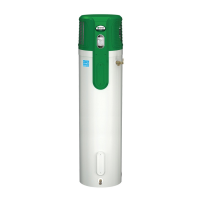
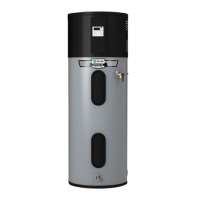




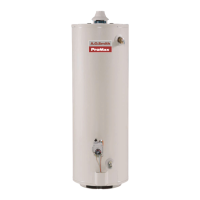
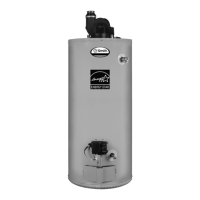
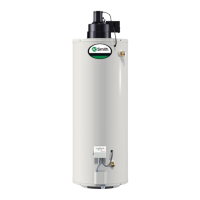
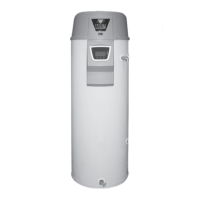
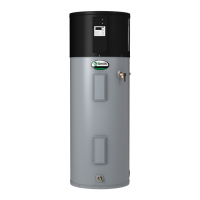
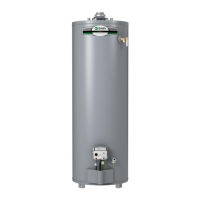
